Uncovering Unique Green Algae and Cyanobacteria Isolated from Biocrusts in Highly Saline Potash Tailing Pile Habitats, Using an Integrative Approach
Abstract
:1. Introduction
2. Materials and Methods
2.1. Algal and Cyanobacteria Isolates and Their Maintenance
2.2. DNA Extraction, PCR, and Sequencing
2.3. Phylogenetic Analyses
3. Results
3.1. SSU rRNA Gene Phylogeny
3.2. ITS Phylogeny
3.3. Morphological Observations
4. Discussion
4.1. Morphological vs. Molecular Species Determination
4.2. Taxa with Unclear Phylogenetic Positions
4.3. Congruence and Divergence of Phylogeny and Habitat Characteristics Regarding Salinity
5. Conclusions
Supplementary Materials
Author Contributions
Funding
Acknowledgments
Conflicts of Interest
References
- Belnap, J.; Büdel, B.; Weber, B. Biological soil crusts as an organizing principle in drylands. In Biological Soil Crusts: An Organizing Principle in Drylands; Weber, B., Büdel, B., Belnap, J., Eds.; Springer International Publishing: Cham, Switzerland, 2016; ISBN 978-3-319-30212-6. [Google Scholar]
- Weber, B.; Büdel, B.; Belnap, J. Biological Soil Crusts: An Organizing Principle in Drylands; Weber, B., Büdel, B., Belnap, J., Eds.; Springer International Publishing: Cham, Switzerland, 2016; ISBN 978-3-319-30212-6. [Google Scholar]
- Evans, R.D.; Johansen, J.R. Microbiotic Crusts and Ecosystem Processes. Crit. Rev. Plant Sci. 1999, 18, 183–225. [Google Scholar] [CrossRef]
- Chen, N.; Yu, K.; Jia, R.; Teng, J.; Zhao, C. Biocrust as one of multiple stable states in global drylands. Sci. Adv. 2020, 6, eaay3763. [Google Scholar] [CrossRef] [PubMed]
- Pietrasiak, N.; Johansen, J.R.; Ladoux, T.; Graham, R.C. Comparison of Disturbance Impacts to and Spatial Distribution of Biological Soil Crusts in the Little San Bernardino Mountains of Joshua Tree National Park, California. West. North Am. Nat. 2011, 71, 539–552. [Google Scholar] [CrossRef]
- Eldridge, D.J.; Woodhouse, J.N.; Curlevski, N.J.A.; Hayward, M.; Brown, M.V.; Neilan, B.A. Soil-foraging animals alter the composition and co-occurrence of microbial communities in a desert shrubland. ISME J. 2015, 9, 2671–2681. [Google Scholar] [CrossRef] [Green Version]
- Rao, B.; Liu, Y.; Lan, S.; Wu, P.; Wang, W.; Li, D. Effects of sand burial stress on the early developments of cyanobacterial crusts in the field. Eur. J. Soil Biol. 2012, 48, 48–55. [Google Scholar] [CrossRef]
- Cantón, Y.; Chamizo, S.; Rodriguez-Caballero, E.; Lázaro, R.; Roncero-Ramos, B.; Román, J.R.; Solé-Benet, A. Water Regulation in Cyanobacterial Biocrusts from Drylands: Negative Impacts of Anthropogenic Disturbance. Water 2020, 12, 720. [Google Scholar] [CrossRef] [Green Version]
- Rodriguez-Caballero, E.; Belnap, J.; Büdel, B.; Crutzen, P.J.; Andreae, M.O.; Pöschl, U.; Weber, B. Dryland photoautotrophic soil surface communities endangered by global change. Nat. Geosci. 2018, 11, 185–189. [Google Scholar] [CrossRef]
- Antoninka, A.; Faist, A.; Rodriguez-Caballero, E.; Young, K.E.; Chaudhary, V.B.; Condon, L.A.; Pyke, D.A. Biological soil crusts in ecological restoration: Emerging research and perspectives. Restor. Ecol. 2020, 28, S3–S8. [Google Scholar] [CrossRef]
- Antoninka, A.; Bowker, M.A.; Chuckran, P.; Barger, N.N.; Reed, S.; Belnap, J. Maximizing establishment and survivorship of field-collected and greenhouse-cultivated biocrusts in a semi-cold desert. Plant Soil 2017, 429, 213–225. [Google Scholar] [CrossRef]
- Muñoz-Rojas, M.; Chilton, A.; Liyanage, G.S.; Erickson, T.E.; Merritt, D.J.; Neilan, B.A.; Ooi, M.K.J. Effects of indigenous soil cyanobacteria on seed germination and seedling growth of arid species used in restoration. Plant Soil 2018, 429, 91–100. [Google Scholar] [CrossRef]
- Xiao, B.; Zhao, Y.; Wang, Q.; Li, C. Development of artificial moss-dominated biological soil crusts and their effects on runoff and soil water content in a semi-arid environment. J. Arid. Environ. 2015, 117, 75–83. [Google Scholar] [CrossRef]
- Chen, L.; Xie, Z.; Hu, C.; Li, D.; Wang, G.; Liu, Y. Man-made desert algal crusts as affected by environmental factors in Inner Mongolia, China. J. Arid. Environ. 2006, 67, 521–527. [Google Scholar] [CrossRef]
- Green, T.G.A.; Proctor, M.C.F. Physiology of Photosynthetic Organisms within Biological Soil Crusts: Their Adaptation, Flexibility, and Plasticity. In Biological Soil Crusts: An Organizing Principle in Drylands; Weber, B., Büdel, B., Belnap, J., Eds.; Springer International Publishing: Cham, Switzerland, 2016; pp. 347–381. [Google Scholar]
- Rossi, F.; Mugnai, G.; De Philippis, R. Complex role of the polymeric matrix in biological soil crusts. Plant Soil 2017, 429, 19–34. [Google Scholar] [CrossRef]
- Karsten, U.; Holzinger, A. Green algae in alpine biological soil crust communities: Acclimation strategies against ultraviolet radiation and dehydration. Biodivers. Conserv. 2014, 23, 1845–1858. [Google Scholar] [CrossRef] [PubMed] [Green Version]
- Pfaff, S.; Borchhardt, N.; Boy, J.; Karsten, U.; Gustavs, L. Desiccation tolerance and growth-temperature requirements of Coccomyxa (Trebouxiophyceae, Chlorophyta) strains from Antarctic biological soil crusts. Algological Stud. 2016, 151, 3–19. [Google Scholar] [CrossRef]
- Couradeau, E.; Felde, V.J.M.N.L.; Parkinson, D.; Uteau, D.; Rochet, A.; Cuellar, C.; Winegar, G.; Peth, S.; Northen, T.R.; Garcia-Pichel, F. In Situ X-ray Tomography Imaging of Soil Water and Cyanobacteria from Biological Soil Crusts Undergoing Desiccation. Front. Environ. Sci. 2018, 6, 65. [Google Scholar] [CrossRef]
- Abed, R.M.M.; Polerecky, L.; Al-Habsi, A.; Oetjen, J.; Strous, M.; De Beer, D. Rapid Recovery of Cyanobacterial Pigments in Desiccated Biological Soil Crusts following Addition of Water. PLoS ONE 2014, 9, e112372. [Google Scholar] [CrossRef] [PubMed]
- Whitney, K.M.; Vivoni, E.R.; Duniway, M.C.; Bradford, J.B.; Reed, S.C.; Belnap, J. Ecohydrological role of biological soil crusts across a gradient in levels of development. Ecohydrology 2017, 10, e1875. [Google Scholar] [CrossRef]
- Lafuente, A.; Berdugo, M.; De Guevara, M.L.; Gozalo, B.; Maestre, F.T. Simulated climate change affects how biocrusts modulate water gains and desiccation dynamics after rainfall events. Ecohydrology 2018, 11, e1935. [Google Scholar] [CrossRef]
- Holzinger, A.; Lütz, C.; Karsten, U. Desiccation stress causes structural and ultrastructural alterations in the aeroterrestrial green alga Klebsormidium crenulatum (Klebsormidiophyceae, Streptophyta) isolated from an alpine soil crust. J. Phycol. 2011, 47, 591–602. [Google Scholar] [CrossRef]
- Karsten, U.; Herburger, K.; Holzinger, A. Dehydration, temperature, and light tolerance in members of the aeroterrestrial green algal genus Interfilum (Streptophyta) from biogeographically different temperate soils. J. Phycol. 2014, 50, 804–816. [Google Scholar] [CrossRef] [PubMed]
- Hagemann, M. Molecular biology of cyanobacterial salt acclimation. FEMS Microbiol. Rev. 2011, 35, 87–123. [Google Scholar] [CrossRef] [PubMed]
- Pade, N.; Hagemann, M. Salt Acclimation of Cyanobacteria and Their Application in Biotechnology. Life 2014, 5, 25–49. [Google Scholar] [CrossRef]
- Kirst, G.O. Salinity Tolerance of Eukaryotic Marine Algae. Annu. Rev. Plant Biol. 1990, 41, 21–53. [Google Scholar] [CrossRef]
- Karsten, U. Seaweed acclimation to salinity and desiccation stress. In Seaweed Biology: Novel Insights into Ecophysiology, Ecology and Utilization. Ecological Studies 219; Wiencke, C., Bischof, K., Eds.; Springer: Berlin/Heidelberg, Germany, 2012; pp. 87–107. ISBN 978-3-642-28451-9. [Google Scholar]
- Church, J.; Hwang, J.-H.; Kim, K.-T.; McLean, R.; Oh, Y.-K.; Nam, B.; Joo, J.C.; Lee, W.H. Effect of salt type and concentration on the growth and lipid content of Chlorella vulgaris in synthetic saline wastewater for biofuel production. Bioresour. Technol. 2017, 243, 147–153. [Google Scholar] [CrossRef]
- Ishika, T.; Bahri, P.A.; Laird, D.W.; Moheimani, N.R. The effect of gradual increase in salinity on the biomass productivity and biochemical composition of several marine, halotolerant, and halophilic microalgae. J. Appl. Phycol. 2018, 30, 1453–1464. [Google Scholar] [CrossRef]
- Menke, S.; Sennhenn, A.; Sachse, J.-H.; Majewski, E.; Huchzermeyer, B.; Rath, T. Screening of Microalgae for Feasible Mass Production in Industrial Hypersaline Wastewater Using Disposable Bioreactors. CLEAN Soil Air Water 2012, 40, 1401–1407. [Google Scholar] [CrossRef]
- Sabbe, K.; Hodgson, D.A.; Verleyen, E.; Taton, A.; Wilmotte, A.; Vanhoutte, K.; Vyverman, W. Salinity, depth and the structure and composition of microbial mats in continental Antarctic lakes. Freshw. Biol. 2004, 49, 296–319. [Google Scholar] [CrossRef]
- Krumbein, W.E.; Gorbushina, A.A.; Holtkamp-Tacken, E. Hypersaline Microbial Systems of Sabkhas: Examples of Life’s Survival in “Extreme” Conditions. Astrobiology 2004, 4, 450–459. [Google Scholar] [CrossRef]
- John, J.; Hay, M.; Paton, J. Cyanobacteria in benthic microbial communities in coastal salt lakes in Western Australia. Algological Stud. 2009, 130, 125–135. [Google Scholar] [CrossRef]
- Huang, I.-S.; Pinnell, L.J.; Turner, J.W.; Abdulla, H.; Boyd, L.; Linton, E.W.; Zimba, P.V. Preliminary Assessment of Microbial Community Structure of Wind-Tidal Flats in the Laguna Madre, Texas, USA. Biology 2020, 9, 183. [Google Scholar] [CrossRef]
- Ramos, V.M.C.; Castelo-Branco, R.; Leão, P.N.; Martins, J.; Carvalhal-Gomes, S.; Da Silva, F.S.; Filho, J.G.M.; Vasconcelos, V.M. Cyanobacterial Diversity in Microbial Mats from the Hypersaline Lagoon System of Araruama, Brazil: An in-depth Polyphasic Study. Front. Microbiol. 2017, 8, 1233. [Google Scholar] [CrossRef] [PubMed] [Green Version]
- Santhanakrishnan, T.; Lakshmanan, C.; Radhakrishnan, V. Mineralogical composition and microalgae communities of solar salt tumuli from Tuticorin, Southeast coast of India. Indian J. Geo-Marine Sci. 2018, 47, 498–502. [Google Scholar]
- Chatchawan, T.; Peerapornpisal, Y.; Komarek, J. Diversity of cyanobacteria in man-made solar saltern, Petchaburi Province, Thailand—A pilot study. Fottea 2011, 11, 203–214. [Google Scholar] [CrossRef] [Green Version]
- Sørensen, K.B.; Canfield, D.E.; Oren, A. Salinity Responses of Benthic Microbial Communities in a Solar Saltern (Eilat, Israel). Appl. Environ. Microbiol. 2004, 70, 1608–1616. [Google Scholar] [CrossRef] [Green Version]
- Brock, T.D. Salinity and the Ecology of Dunaliella from Great Salt Lake. J. Gen. Microbiol. 1975, 89, 285–292. [Google Scholar] [CrossRef] [Green Version]
- Conner, A.J.; Benison, K.C. Acidophilic Halophilic Microorganisms in Fluid Inclusions in Halite from Lake Magic, Western Australia. Astrobiology 2013, 13, 850–860. [Google Scholar] [CrossRef] [PubMed] [Green Version]
- Kirkwood, A.E.; Buchheim, J.A.; Buchheim, M.A.; Henley, W.J. Cyanobacterial Diversity and Halotolerance in a Variable Hypersaline Environment. Microb. Ecol. 2007, 55, 453–465. [Google Scholar] [CrossRef] [PubMed]
- Vinogradova, O.N.; Darienko, T.M. Algae of Azovo-Syvashsky National Nature Park (Ukraine). Int. J. Algae 2008, 10, 163–178. [Google Scholar] [CrossRef]
- Canfora, L.; Vendramin, E.; Antisari, L.V.; Papa, G.L.; Dazzi, C.; Benedetti, A.; Iavazzo, P.; Adamo, P.; Jungblut, A.D.; Pinzari, F. Compartmentalization of gypsum and halite associated with cyanobacteria in saline soil crusts. FEMS Microbiol. Ecol. 2016, 92, 1–13. [Google Scholar] [CrossRef] [Green Version]
- Tsujimura, S.; Nakahara, H.; Kosaki, T.; Ishida, N.; Iskakov, A.R. Distribution of soil algae in salinized irrigation land in the arid region of Central Asia. Soil Sci. Plant Nutr. 1998, 44, 67–76. [Google Scholar] [CrossRef]
- Kirkwood, A.E.; Henley, W.J. Algal community dynamics and halotolerance in a terrestrial, hypersaline environment. J. Phycol. 2006, 42, 537–547. [Google Scholar] [CrossRef]
- Buchheim, M.A.; Kirkwood, A.E.; Buchheim, J.A.; Verghese, B.; Henley, W.J. Hypersaline soil supports a diverse community of Dunaliella (Chlorophyceae). J. Phycol. 2010, 46, 1038–1047. [Google Scholar] [CrossRef]
- Arabadzhy-Tipenko, L.I.; Solonenko, A.N.; Bren, A.G. Cyanoprokaryota of the Salt Marshes at the Pryazov National Natural Park, Ukraine. Int. J. Algae 2019, 21, 299–310. [Google Scholar] [CrossRef]
- Novichkova-Ivanova, L.N. Soil Algae in Phytocenosis of the Sachara-Gobi Desert Region; Nauka: Leningrad, Russia, 1980. (In Russian) [Google Scholar]
- Prikhodkova, L.P. Blue-Green Algae of Soils of the Steppe Zone of Ukraine; Naukova Dumka Press: Kiev, Ukraine, 1992. (In Russian) [Google Scholar]
- Vinogradova, O.M.; Darienko, T.M. Terrestrial algae of hypersaline environments of the Central Syvash islands (Kherson Region, Ukraine). Biologia 2008, 63, 813–823. [Google Scholar] [CrossRef] [Green Version]
- Vinogradova, O.M. Cyanoprokaryota of Hypersaline Ecosystems of Ukraine; Alterpress: Kiev, Ukraine, 2012. (In Ukrainian) [Google Scholar]
- Patzelt, D.J.; Hodač, L.; Friedl, T.; Pietrasiak, N.; Johansen, J.R. Biodiversity of soil cyanobacteria in the hyper-arid Atacama Desert, Chile. J. Phycol. 2014, 50, 698–710. [Google Scholar] [CrossRef]
- Kaushal, S.S.; Likens, G.E.; Pace, M.L.; Utz, R.M.; Haq, S.; Gorman, J.; Grese, M. Freshwater salinization syndrome on a continental scale. Proc. Natl. Acad. Sci. USA 2018, 115, E574–E583. [Google Scholar] [CrossRef] [Green Version]
- Wang, H.; Jia, G. Satellite-based monitoring of decadal soil salinization and climate effects in a semi-arid region of China. Adv. Atmos. Sci. 2012, 29, 1089–1099. [Google Scholar] [CrossRef]
- Litalien, A.; Zeeb, B. Curing the earth: A review of anthropogenic soil salinization and plant-based strategies for sustainable mitigation. Sci. Total Environ. 2020, 698, 134235. [Google Scholar] [CrossRef]
- Cañedo-Argüelles, M.; Brucet, S.; Carrasco, S.; Flor-Arnau, N.; Ordeix, M.; Ponsá, S.; Coring, E. Effects of potash mining on river ecosystems: An experimental study. Environ. Pollut. 2017, 224, 759–770. [Google Scholar] [CrossRef]
- Siefert, B.; Büchel, G.; Lebküchner-Neugebauer, J. Potash mining waste pile Sollstedt (Thuringia): Investigations of the spreading of waste solutes in the Roethian Karst. Grundwasser 2006, 11, 99–110. [Google Scholar] [CrossRef]
- John, H. Zur Ausbreitung von Halophyten und salztoleranten Pflanzen in der Umgebung von Kali-Rückstandshalden am Beispiel des FND “Salzstelle bei Teutschenthal-Bahnhof“ (Saalkreis). Mitt. Florist. Kart. Sachsen-Anhalt 2000, 5, 175–197. [Google Scholar]
- Garve, E.; Garve, V. Halophyten an Kalihalden in Deutschland und Frankreich (Eisass). Tuexenia 2000, 20, 375–417. [Google Scholar]
- Guder, C. Kalihalden als Modellobjekte der kleinräumigen Florendynamik dargestellt an Untersuchungen im nördlichen Harzvorland. Braunschw. Nat. Schr. 1998, 5, 641–665. [Google Scholar]
- Eilmus, S.; Rösch, C.; Bothe, H. Prokaryotic life in a potash-polluted marsh with emphasis on N-metabolizing microorganisms. Environ. Pollut. 2007, 146, 478–491. [Google Scholar] [CrossRef]
- Sommer, V.; Karsten, U.; Glaser, K. Halophilic Algal Communities in Biological Soil Crusts Isolated from Potash Tailings Pile Areas. Front. Ecol. Evol. 2020, 8, 46. [Google Scholar] [CrossRef] [Green Version]
- Gustavs, L.; Eggert, A.; Michalik, D.; Karsten, U. Physiological and biochemical responses of green microalgae from different habitats to osmotic and matric stress. Protoplasma 2010, 243, 3–14. [Google Scholar] [CrossRef]
- Mikhailyuk, T.; Glaser, K.; Tsarenko, P.; Demchenko, E.; Karsten, U. Composition of biological soil crusts from sand dunes of the Baltic Sea coast in the context of an integrative approach to the taxonomy of microalgae and cyanobacteria. Eur. J. Phycol. 2019, 54, 263–290. [Google Scholar] [CrossRef]
- Komarek, J. Cyanobacterial Taxonomy: Current Problems and Prospects for the Integration of Traditional and Molecular Approaches. ALGAE 2006, 21, 349–375. [Google Scholar] [CrossRef] [Green Version]
- Pröschold, T.; Leliaert, F. Systematics of the green algae: Conflict of classic and modern approaches. In Unravelling the Algae: The Past, Present, and Future of Algal Systematics; Brodie, J., Lewis, J., Eds.; CRC Press: Boca Raton, FL, USA, 2007; pp. 123–154. [Google Scholar]
- Darienko, T.; Gustavs, L.; Mudimu, O.; Menendez, C.R.; Schumann, R.; Karsten, U.; Friedl, T.; Pröschold, T. Chloroidium, a common terrestrial coccoid green alga previously assigned to Chlorella (Trebouxiophyceae, Chlorophyta). Eur. J. Phycol. 2010, 45, 79–95. [Google Scholar] [CrossRef] [Green Version]
- Darienko, T.; Pröschold, T. Toward a monograph of non-marine Ulvophyceae using an integrative approach (Molecular phylogeny and systematics of terrestrial Ulvophyceae II.). Phytotaxa 2017, 324, 1–41. [Google Scholar] [CrossRef] [Green Version]
- Darienko, T.; Pröschold, T. Reevaluation and discovery of new species of the rare genus Watanabea and establishment of Massjukichlorella gen. nov. (Trebouxiophyceae, Chlorophyta) using an integrative approach. J. Phycol. 2019, 55, 493–499. [Google Scholar] [CrossRef] [PubMed]
- Jung, P.; Briegel-Williams, L.; Schermer, M.; Büdel, B. Strong in combination: Polyphasic approach enhances arguments for cold-assigned cyanobacterial endemism. MicrobiolyOpen 2018, 8, e00729. [Google Scholar] [CrossRef]
- Mikhailyuk, T.I.; Vinogradova, O.M.; Glaser, K.; Demchenko, E.; Karsten, U. Diversity of Terrestrial Algae of Cape Kazantip (the Sea of Azov, Ukraine) and Some Remarks on their Phylogeny and Ecology. Int. J. Algae 2018, 20, 313–338. [Google Scholar] [CrossRef]
- Williams, L.; Loewen-Schneider, K.; Maier, S.; Büdel, B. Cyanobacterial diversity of western European biological soil crusts along a latitudinal gradient. FEMS Microbiol. Ecol. 2016, 92, 157. [Google Scholar] [CrossRef] [Green Version]
- Kabirnataj, S.; Nematzadeh, G.A.; Talebi, A.F.; Saraf, A.; Suradkar, A.; Tabatabaei, M.; Singh, P. Description of novel species of Aliinostoc, Desikacharya and Desmonostoc using a polyphasic approach. Int. J. Syst. Evol. Microbiol. 2020, 70, 3413–3426. [Google Scholar] [CrossRef] [PubMed]
- Jung, P.; Mikhailyuk, T.; Emrich, D.; Baumann, K.; Dultz, S.; Büdel, B. Shifting Boundaries: Ecological and Geographical Range extension Based on Three New Species in the Cyanobacterial Genera Cyanocohniella, Oculatella, and, Aliterella. J. Phycol. 2020, 56, 1216–1231. [Google Scholar] [CrossRef]
- Kaštovský, J.; Gomez, E.B.; Hladil, J.; Johansen, J.R. Cyanocohniella calida gen. et sp. nov. (Cyanobacteria: Aphanizomenonaceae) a new cyanobacterium from the thermal springs from Karlovy Vary, Czech Republic. Phytotaxa 2014, 181, 279–292. [Google Scholar] [CrossRef]
- Pietrasiak, N.; Osorio-Santos, K.; Shalygin, S.; Martin, M.P.; Johansen, J.R. When Is A Lineage A Species? A Case Study in Myxacorys gen. nov. (Synechococcales: Cyanobacteria) with the Description of Two New Species from the Americas. J. Phycol. 2019, 55, 976–996. [Google Scholar] [CrossRef]
- Komárek, J. A polyphasic approach for the taxonomy of cyanobacteria: Principles and applications. Eur. J. Phycol. 2016, 51, 346–353. [Google Scholar] [CrossRef]
- Komárek, J.; Kaštovský, J.; Mareš, J.; Johansen, J.R. Taxonomic classification of cyanoprokaryotes (cyanobacterial genera) 2014, using a polyphasic approach. Preslia 2014, 86, 295–335. [Google Scholar]
- Komarek, J. Quo vadis, taxonomy of cyanobacteria (2019). Fottea 2020, 20, 104–110. [Google Scholar] [CrossRef] [Green Version]
- Fawley, M.W.; Fawley, K.P. Identification of eukaryotic microalgal strains. J. Appl. Phycol. 2020, 32, 2699–2709. [Google Scholar] [CrossRef]
- Mikhailyuk, T.; Vinogradova, O.M.; Holzinger, A.; Glaser, K.; Samolov, E.; Karsten, U. New record of the rare genus Crinalium Crow (Oscillatoriales, Cyanobacteria) from sand dunes of the Baltic Sea, Germany: Epitypification and emendation of Crinalium magnum Fritsch et John based on an integrative approach. Phytotaxa 2019, 400, 165–179. [Google Scholar] [CrossRef] [PubMed] [Green Version]
- Samolov, E.; Mikhailyuk, T.; Lukešová, A.; Glaser, K.; Büdel, B.; Karsten, U. Usual alga from unusual habitats: Biodiversity of Klebsormidium (Klebsormidiophyceae, Streptophyta) from the phylogenetic superclade G isolated from biological soil crusts. Mol. Phylogenetics Evol. 2019, 133, 236–255. [Google Scholar] [CrossRef] [PubMed]
- Starr, R.C.; Zeiskus, J.A. UTEX—The Culture Collection of Algae at the University of Texas at Austin. J. Phycol. 1993, 29, 1–106. [Google Scholar] [CrossRef]
- Stanier, R.Y.; Kunisawa, R.; Mandel, M.; Cohen-Bazire, G. Purification and properties of unicellular blue-green algae (order Chroococcales). Bacteriol. Rev. 1971, 35, 171–205. [Google Scholar] [CrossRef] [Green Version]
- Mikhailyuk, T.; Lukešová, A.; Glaser, K.; Holzinger, A.; Obwegeser, S.; Nyporko, S.; Friedl, T.; Karsten, U. New Taxa of Streptophyte Algae (Streptophyta) from Terrestrial Habitats Revealed Using an Integrative Approach. Protist 2018, 169, 406–431. [Google Scholar] [CrossRef]
- Marin, B.; Palm, A.; Klingberg, M.; Melkonian, M. Phylogeny and Taxonomic Revision of Plastid-Containing Euglenophytes based on SSU rDNA Sequence Comparisons and Synapomorphic Signatures in the SSU rRNA Secondary Structure. Protist 2003, 154, 99–145. [Google Scholar] [CrossRef]
- Marin, B.; Klingberg, M.; Melkonian, M. Phylogenetic Relationships among the Cryptophyta: Analyses of Nuclear-Encoded SSU rRNA Sequences Support the Monophyly of Extant Plastid-Containing Lineages. Protist 1998, 149, 265–276. [Google Scholar] [CrossRef]
- Wilmotte, A.; Van Der Auwera, G.; De Wachter, R. Structure of the 16 S ribosomal RNA of the thermophilic cyanobacterium chlorogloeopsis HTF (‘mastigocladus laminosus HTF’) strain PCC7518, and phylogenetic analysis. FEBS Lett. 1993, 317, 96–100. [Google Scholar] [CrossRef] [Green Version]
- Lane, D.J. 16S/23S rRNA sequencing. In Nucleic Acid Techniques in Bacterial Systematics; Stackebrandt, E., Goodfellow, M., Eds.; John Wiley and Sons: Hoboken, NJ, USA, 1991; pp. 115–175. [Google Scholar]
- Hoef-Emden, K.; Melkonian, M. Revision of the Genus Cryptomonas (Cryptophyceae): A Combination of Molecular Phylogeny and Morphology Provides Insights into a Long-Hidden Dimorphism. Protist 2003, 154, 371–409. [Google Scholar] [CrossRef]
- Goff, L.J.; Moon, D.A. PCR amplification of nuclear and plastid genes from algal herbarium specimens and algal spores. J. Phycol. 1993, 29, 381–384. [Google Scholar] [CrossRef]
- Marin, B.; Nowack, E.C.M.; Melkonian, M. A Plastid in the Making: Evidence for a Second Primary Endosymbiosis. Protist 2005, 156, 425–432. [Google Scholar] [CrossRef] [PubMed]
- Altschul, S.F.; Gish, W.; Miller, W.; Myers, E.W.; Lipman, D.J. Basic Local Alignment Search Tool. J. Mol. Biol. 1990, 215, 403–410. [Google Scholar] [CrossRef]
- Edgar, R.C. MUSCLE: Multiple sequence alignment with high accuracy and high throughput. Nucleic Acids Res. 2004, 32, 1792–1797. [Google Scholar] [CrossRef] [Green Version]
- Ronquist, F.; Teslenko, M.; Van Der Mark, P.; Ayres, D.L.; Darling, A.; Höhna, S.; Larget, B.; Liu, L.; Suchard, M.A.; Huelsenbeck, J.P. MrBayes 3.2: Efficient Bayesian Phylogenetic Inference and Model Choice across a Large Model Space. Syst. Biol. 2012, 61, 539–542. [Google Scholar] [CrossRef] [Green Version]
- Bock, C.; Krienitz, L.; Pröschold, T. Taxonomic reassessment of the genus Chlorella (Trebouxiophyceae) using molecular signatures (barcodes), including description of seven new species. Fottea 2011, 11, 293–312. [Google Scholar] [CrossRef] [Green Version]
- Kumar, S.; Stecher, G.; Li, M.; Knyaz, C.; Tamura, K. MEGA X: Molecular Evolutionary Genetics Analysis across Computing Platforms. Mol. Biol. Evol. 2018, 35, 1547–1549. [Google Scholar] [CrossRef]
- Guiry, M.D.; Guiry, G.M. AlgaeBase; World-Wide Electronic Publication. National University of Ireland: Galway, Ireland, 2020. Available online: https://www.algaebase.org (accessed on 4 September 2020).
- Ettl, H.; Gärtner, G. Syllabus der Boden- Luft- und Flechtenalgen, 2nd ed.; Springer: Berlin/Heidelberg, Germany, 2014; ISBN 978-3-642-39461-4. [Google Scholar]
- Henley, W.J.; Hironaka, J.L.; Guillou, L.; Buchheim, M.A.; Buchheim, J.A.; Fawley, M.W.; Fawley, K.P. Phylogenetic analysis of the ‘Nannochloris-like’ algae and diagnoses of Picochlorum oklahomensis gen. et sp. nov. (Trebouxiophyceae, Chlorophyta). Phycologia 2004, 43, 641–652. [Google Scholar] [CrossRef]
- Hodač, L.; Hallmann, C.; Spitzer, K.; Elster, J.; Faßhauer, F.; Brinkmann, N.; Lepka, D.; Diwan, V.; Friedl, T. Widespread green algae Chlorella and Stichococcus exhibit polar-temperate and tropical-temperate biogeography. FEMS Microbiol. Ecol. 2016, 92, fiw122. [Google Scholar] [CrossRef] [Green Version]
- Nakada, T.; Nozaki, H.; Pröschold, T. Molecular phylogeny, ultrastructure, and taxonomic revision Ofchlorogonium (Chlorophyta): Emendation Ofchlorogonium and description of Gungnir gen. nov. and Rusalka gen. nov. J. Phycol. 2008, 44, 751–760. [Google Scholar] [CrossRef] [PubMed]
- Dykstra, R.F. Borodinellopsis texensis: Gen. et sp. nov. A new alga from the Texas Gulf coast. In Contributions in Phycology; Parker, B., Brown, R.M.J., Eds.; Phycological Society of America: Lawrence, KS, USA, 1971; pp. 1–8. [Google Scholar]
- Watanabe, S.; Lewis, L.A. Phylogenetic interpretation of light and electron microscopic features of selected members of the phylogroup Moewusinia (Chlorophyceae), with new generic taxonomy. Phycologia 2017, 56, 329–353. [Google Scholar] [CrossRef]
- Matsuzaki, R.; Nakada, T.; Hara, Y.; Nozaki, H. Description of Chloromonas kasaiae sp. nov. (Volvocales, Chlorophyceae), based on comparative electron microscopy and molecular data. Phycologia 2013, 52, 239–245. [Google Scholar] [CrossRef]
- Matsuzaki, R.; Hara, Y.; Nozaki, H. A taxonomic revision of Chloromonas reticulata (Volvocales, Chlorophyceae), the type species of the genus Chloromonas, based on multigene phylogeny and comparative light and electron microscopy. Phycologia 2012, 51, 74–85. [Google Scholar] [CrossRef]
- Pröschold, T.; Marin, B.; Schlösser, U.G.; Melkonian, M. Molecular Phylogeny and Taxonomic Revision of (Chlorophyta). I. Emendation of Chlamydomonas ehrenberg and Chloromonas gobi, and description of Oogamochlamys gen. nov. and Lobochlamys gen. nov. Protist 2001, 152, 265–300. [Google Scholar] [CrossRef] [PubMed]
- Fuíková, K.; Flechtner, V.R.; Lewis, L.A. Revision of the genus Bracteacoccus Tereg (Chlorophyceae, Chlorophyta) based on a phylogenetic approach. Nova Hedwigia 2013, 96, 15–59. [Google Scholar] [CrossRef]
- Wynne, M.J.; Hallan, J.K. Reinstatement of Tetradesmus G. M. Smith (Sphaeropleales, Chlorophyta). Feddes Repert. 2015, 126, 83–86. [Google Scholar] [CrossRef]
- Kaufnerová, V.; Eliáš, M. The demise of the genus Scotiellopsis Vinatzer (Chlorophyta). Nova Hedwigia 2013, 97, 415–428. [Google Scholar] [CrossRef] [Green Version]
- Darienko, T.; Friedl, T.; Pröschold, T. Desmochloris mollenhaueri a new terrestrial ulvophycean alga from south-west African soils. (Molecular phylogeny and systematics of terrestrial Ulvophyceae I.). Algol. Stud. 2009, 129, 25–40. [Google Scholar] [CrossRef]
- Watanabe, S.; Kuroda, N.; Maiwa, F. Phylogenetic status of Helicodictyon planctonicum and Desmochloris halophila gen. et comb. nov. and the definition of the class Ulvophyceae (Chlorophyta). Phycologia 2001, 40, 421–434. [Google Scholar] [CrossRef]
- Dangeard, P.J.L.; Guiry, M.D. Validation of some invalid names for green algae introduced by P.J.L. Dangeard. Not. Algarum 2017, 42, 1–2. [Google Scholar]
- O’Kelly, C.J.; Wysor, B.; Bellows, W.K. Collinsiella (Ulvophyceae, Chlorophyta) and other ulotrichalean taxa with shell-boring sporophytes form a monophyletic clade. Phycologia 2004, 43, 41–49. [Google Scholar] [CrossRef]
- Lindstrom, S.C.; Hanic, L.A. The phylogeny of North American Urospora (Ulotrichales, Chlorophyta) based on sequence analysis of nuclear ribosomal genes, introns and spacers. Phycologia 2005, 44, 194–201. [Google Scholar] [CrossRef]
- Hanic, L.A.; Lindstrom, S.C. Life History and Systematic Studies of Pseudothrix borealis gen. et sp. nov. (=North Pacific Capsosiphon groenlandicus, Ulotrichaceae, Chlorophyta). ALGAE 2008, 23, 119–133. [Google Scholar] [CrossRef]
- Darienko, T.; Lukešová, A.; Pröschold, T. The polyphasic approach revealed new species of Chloroidium (Trebouxiophyceae, Chlorophyta). Phytotaxa 2018, 372, 51–66. [Google Scholar] [CrossRef]
- Pröschold, T.; Darienko, T. The green puzzle Stichococcus (Trebouxiophyceae, Chlorophyta): New generic and species concept among this widely distributed genus. Phytotaxa 2020, 441, 113–142. [Google Scholar] [CrossRef]
- Fawley, M.W.; Fawley, K.P.; Buchheim, M.A. Molecular Diversity among Communities of Freshwater Microchlorophytes. Microb. Ecol. 2004, 48, 489–499. [Google Scholar] [CrossRef]
- Darienko, T.; Gustavs, L.; Pröschold, T. Species concept and nomenclatural changes within the genera Elliptochloris and Pseudochlorella (Trebouxiophyceae) based on an integrative approach. J. Phycol. 2016, 52, 1125–1145. [Google Scholar] [CrossRef]
- Perkerson, R.B.I.; Johansen, J.R.; Kovácik, L.; Brand, J.; Kaštovský, J.; Casamatta, D.A. A unique pseudanabaenalean (Cyanobacteria) genus Nodosilinea gen. nov. based on morphological and molecular data. J. Phycol. 2011, 47, 1397–1412. [Google Scholar] [CrossRef]
- Radzi, R.; Muangmai, N.; Broady, P.; Omar, W.M.W.; Lavoue, S.; Convey, P.; Merican, F.M.M.S. Nodosilinea signiensis sp. nov. (Leptolyngbyaceae, Synechococcales), a new terrestrial cyanobacterium isolated from mats collected on Signy Island, South Orkney Islands, Antarctica. PLoS ONE 2019, 14, e0224395. [Google Scholar] [CrossRef]
- Darienko, T.; Gustavs, L.; Eggert, A.; Wolf, W.; Pröschold, T. Evaluating the Species Boundaries of Green Microalgae (Coccomyxa, Trebouxiophyceae, Chlorophyta) Using Integrative Taxonomy and DNA Barcoding with Further Implications for the Species Identification in Environmental Samples. PLoS ONE 2015, 10, e0127838. [Google Scholar] [CrossRef]
- Mikhailyuk, T.I. Terrestrial Algae from the Granite Outcrops of River Valleys of the Ukraine. Int. J. Algae 2013, 15, 311–330. [Google Scholar] [CrossRef]
- Schwarz, K. Neue Bodenalgen aus Dalmatien. Plant Syst. Evol. 1979, 131, 193–209. [Google Scholar] [CrossRef]
- Jónsson, S. The status of the Acrosiphoniales (Chlorophyta). Rit Fiskid. 1999, 16, 187–196. [Google Scholar]
- Sciuto, K.; Lewis, L.A.; Verleyen, E.; Moro, I.; La Rocca, N. Chodatodesmus australis sp. nov. (Scenedesmaceae, Chlorophyta) from Antarctica, with the emended description of the genus Chodatodesmus, and circumscription of Flechtneria rotunda gen. et sp. nov. J. Phycol. 2015, 51, 1172–1188. [Google Scholar] [CrossRef] [PubMed]
- Wynne, M.J.; Furnari, G. A census of J.P.L.Dangeard’s invalid taxa with proposals to resolve the nomenclatural problems of some of them. Nova Hedwigia 2014, 98, 515–527. [Google Scholar] [CrossRef]
- Dangeard, P. Sur quelques algues vertes marines nouvelles observées en culture. Botaniste 1966, 49, 5–45. [Google Scholar]
- Davydov, D.; Shalygin, S.; Vilnet, A.A. New cyanobacterium Nodosilinea svalbardensis sp. nov. (Prochlorotrichaceae, Synechococcales) isolated from alluvium in Mimer river valley of the Svalbard archipelago. Phytotaxa 2020, 442, 61–79. [Google Scholar] [CrossRef]
- Vázquez-Martínez, J.; Gutierrez-Villagomez, J.M.; Fonseca-García, C.; Ramirez-Chavez, E.; Mondragón-Sánchez, M.L.; Partida-Martínez, L.; Johansen, J.R.; Molina-Torres, J. Nodosilinea chupicuarensis sp. nov. (Leptolyngbyaceae, Synechococcales) a subaerial cyanobacterium isolated from a stone monument in central Mexico. Phytotaxa 2018, 334, 167–182. [Google Scholar] [CrossRef] [Green Version]
- Raabová, L.; Kovacik, L.; Elster, J.; Strunecký, O. Review of the genus Phormidesmis (Cyanobacteria) based on environmental, morphological, and molecular data with description of a new genus Leptodesmis. Phytotaxa 2019, 395, 1–16. [Google Scholar] [CrossRef]
- Pocock, T.; Vetterli, A.; Falk, S. Evidence for phenotypic plasticity in the Antarctic extremophile Chlamydomonas raudensis Ettl. UWO 241. J. Exp. Bot. 2011, 62, 1169–1177. [Google Scholar] [CrossRef]
- Qiao, K.; Takano, T.; Liu, S. Discovery of two novel highly tolerant NaHCO3 Trebouxiophytes: Identification and characterization of microalgae from extreme saline–alkali soil. Algal Res. 2015, 9, 245–253. [Google Scholar] [CrossRef]
- Metting, B. The systematics and ecology of soil algae. Bot. Rev. 1981, 47, 195–312. [Google Scholar] [CrossRef]
- Punčochářová, M.; Kalina, T. Taxonomy of the genus Scotiellopsis Vinatzer (Chlorococcales, Chlorophyta). Arch. Hydrobiol. 1981, 27, 119–147. [Google Scholar] [CrossRef]
- Hanagata, N. New species of Coelastrella and Scenedesmus (Chlorophyceae, Chlorophyta). J. Jpn. Bot. 2001, 76, 129–136. [Google Scholar]
- Verses, P.A.; Trainor, F.R. Dactylococcus dissociatus, a New Species from a Connecticut Cornfield Soil. Phycologia 1966, 6, 79–82. [Google Scholar] [CrossRef]
- Bagchi, S.N.; Dubey, N.; Singh, P. Phylogenetically distant clade of Nostoc-like taxa with the description of Aliinostoc gen. nov. and Aliinostoc morphoplasticum sp. nov. Int. J. Syst. Evol. Microbiol. 2017, 67, 3329–3338. [Google Scholar] [CrossRef] [PubMed]
- Taton, A.; Grubisic, S.; Ertz, D.; Hodgson, D.A.; Piccardi, R.; Biondi, N.; Tredici, M.R.; Mainini, M.; Losi, D.; Marinelli, F.; et al. Polyphasic study of antarctic cyanobacterial strains. J. Phycol. 2006, 42, 1257–1270. [Google Scholar] [CrossRef]
- Cole, J.K.; Hutchison, J.R.; Renslow, R.S.; Kim, Y.-M.; Chrisler, W.B.; Engelmann, H.E.; Dohnalkova, A.; Hu, D.; Metz, T.O.; Fredrickson, J.K.; et al. Phototrophic biofilm assembly in microbial-mat-derived unicyanobacterial consortia: Model systems for the study of autotroph-heterotroph interactions. Front. Microbiol. 2014, 5, 109. [Google Scholar] [CrossRef]
- Alvarenga, D.O.; Rigonato, J.; Branco, L.H.Z.; Melo, I.S.; Fiore, M.F. Phyllonema aviceniicola gen. nov., sp. nov. and Foliisarcina bertiogensis gen. nov., sp. nov., epiphyllic cyanobacteria associated with Avicennia schaueriana leaves. Int. J. Syst. Evol. Microbiol. 2016, 66, 689–700. [Google Scholar] [CrossRef] [PubMed]
- Barcytė, D.; Hodač, L. Watanabea acidotolerans: A new trebouxiophyte lineage (Chlorophyta) inhabiting low pH environments from Europe to South America. Phycol. Res. 2018, 67, 120–127. [Google Scholar] [CrossRef]
- Darienko, T.; Rad-Menéndez, C.; Campbell, C.; Pröschold, T. Are there any true marine Chlorella species? Molecular phylogenetic assessment and ecology of marine Chlorella-like organisms, including a description of Droopiella gen. nov. Syst. Biodivers. 2019, 17, 811–829. [Google Scholar] [CrossRef]
- Sommer, V.; Kockx, M.; Wölk, A.; Glaser, K. Von Vogelkot zu grünen Teppichen. Biol. Unserer Zeit 2019, 49, 122–130. [Google Scholar] [CrossRef]
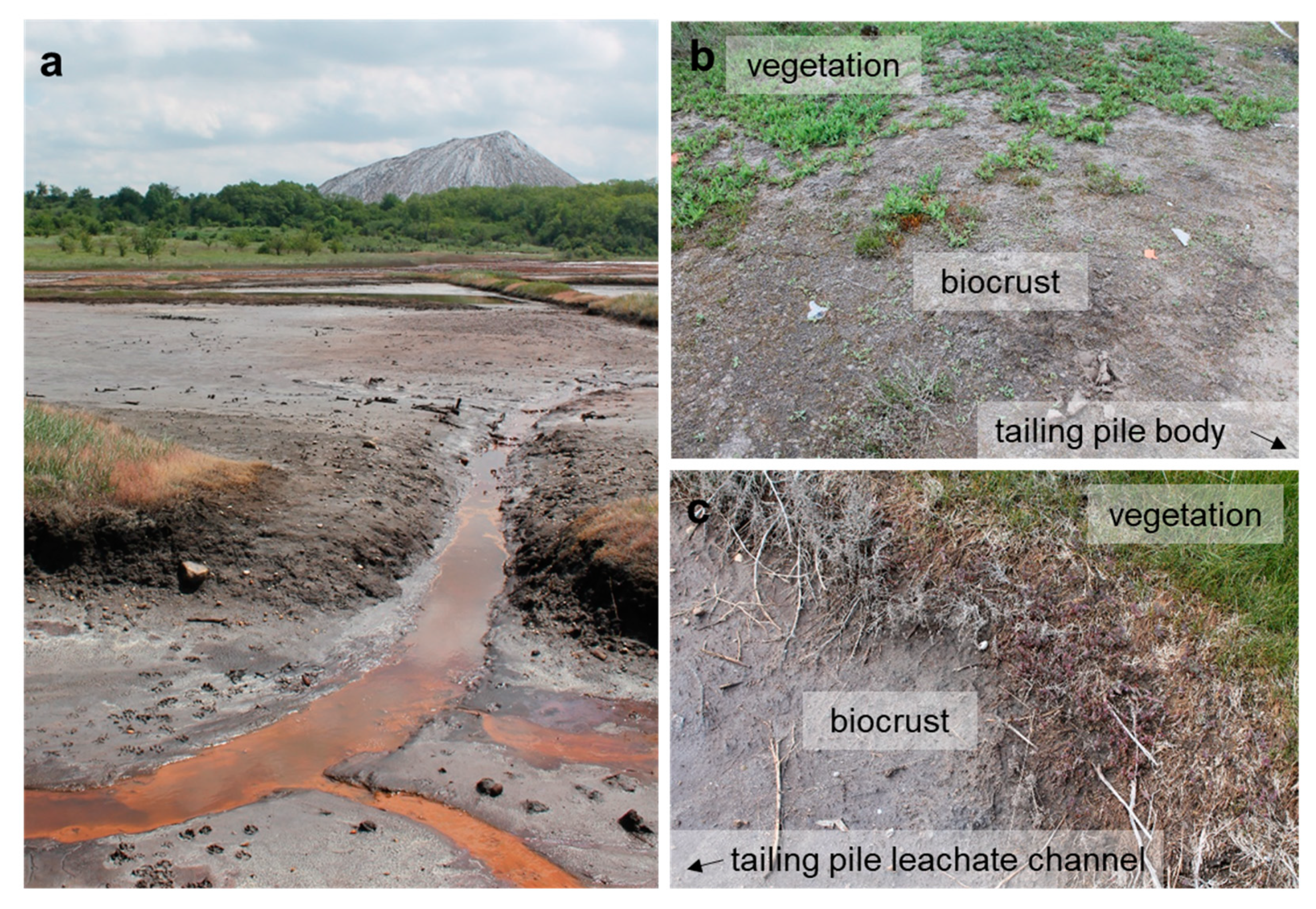
 ); nonsaline (
); nonsaline (  ); and unknown (
); and unknown (  ) habitats.
) habitats.
 ); nonsaline (
); nonsaline (  ); and unknown (
); and unknown (  ) habitats.
) habitats.
 ); nonsaline (
); nonsaline (  ); and unknown (
); and unknown (  ) habitats. 1 Identical to Bracteacoccus minor NN-4-1-CC (MT991529), NN-4-1-H (MT991530), NN-4-1-D2 (MT968390), TTF-1-1-M (MT991533), TTF-2-1-A (MT991534), and TTF-2-1-J (MT991535).
) habitats. 1 Identical to Bracteacoccus minor NN-4-1-CC (MT991529), NN-4-1-H (MT991530), NN-4-1-D2 (MT968390), TTF-1-1-M (MT991533), TTF-2-1-A (MT991534), and TTF-2-1-J (MT991535).
 ); nonsaline (
); nonsaline (  ); and unknown (
); and unknown (  ) habitats. 1 Identical to Bracteacoccus minor NN-4-1-CC (MT991529), NN-4-1-H (MT991530), NN-4-1-D2 (MT968390), TTF-1-1-M (MT991533), TTF-2-1-A (MT991534), and TTF-2-1-J (MT991535).
) habitats. 1 Identical to Bracteacoccus minor NN-4-1-CC (MT991529), NN-4-1-H (MT991530), NN-4-1-D2 (MT968390), TTF-1-1-M (MT991533), TTF-2-1-A (MT991534), and TTF-2-1-J (MT991535).
 ); nonsaline (
); nonsaline (  ), and unknown (
), and unknown (  ) habitats. 1 Identical to Halochlorococcum sp. TT-4-1-M (MT968405), TT-4-1-O (MT968406), NN-4-1-Q (MT968401), NN-4-1-S (MT968402), and NN-4-1-T (MT968403).
) habitats. 1 Identical to Halochlorococcum sp. TT-4-1-M (MT968405), TT-4-1-O (MT968406), NN-4-1-Q (MT968401), NN-4-1-S (MT968402), and NN-4-1-T (MT968403).
 ); nonsaline (
); nonsaline (  ), and unknown (
), and unknown (  ) habitats. 1 Identical to Halochlorococcum sp. TT-4-1-M (MT968405), TT-4-1-O (MT968406), NN-4-1-Q (MT968401), NN-4-1-S (MT968402), and NN-4-1-T (MT968403).
) habitats. 1 Identical to Halochlorococcum sp. TT-4-1-M (MT968405), TT-4-1-O (MT968406), NN-4-1-Q (MT968401), NN-4-1-S (MT968402), and NN-4-1-T (MT968403).
 ); nonsaline (
); nonsaline (  ); other extremes (
); other extremes (  e.g., acidity); and unknown (
e.g., acidity); and unknown (  ) habitats. 1 Identical to Watanabea sp. NN-1-2-X1B (MT968415) and 2 identical to Pseudostichococcus monallantoides SY-1-2-P (MT991549), WT-3-1-A (MW074294), WT-3-1-H (MT991551), and WT-3-1-P1 (MT991552).
) habitats. 1 Identical to Watanabea sp. NN-1-2-X1B (MT968415) and 2 identical to Pseudostichococcus monallantoides SY-1-2-P (MT991549), WT-3-1-A (MW074294), WT-3-1-H (MT991551), and WT-3-1-P1 (MT991552).
 ); nonsaline (
); nonsaline (  ); other extremes (
); other extremes (  e.g., acidity); and unknown (
e.g., acidity); and unknown (  ) habitats. 1 Identical to Watanabea sp. NN-1-2-X1B (MT968415) and 2 identical to Pseudostichococcus monallantoides SY-1-2-P (MT991549), WT-3-1-A (MW074294), WT-3-1-H (MT991551), and WT-3-1-P1 (MT991552).
) habitats. 1 Identical to Watanabea sp. NN-1-2-X1B (MT968415) and 2 identical to Pseudostichococcus monallantoides SY-1-2-P (MT991549), WT-3-1-A (MW074294), WT-3-1-H (MT991551), and WT-3-1-P1 (MT991552).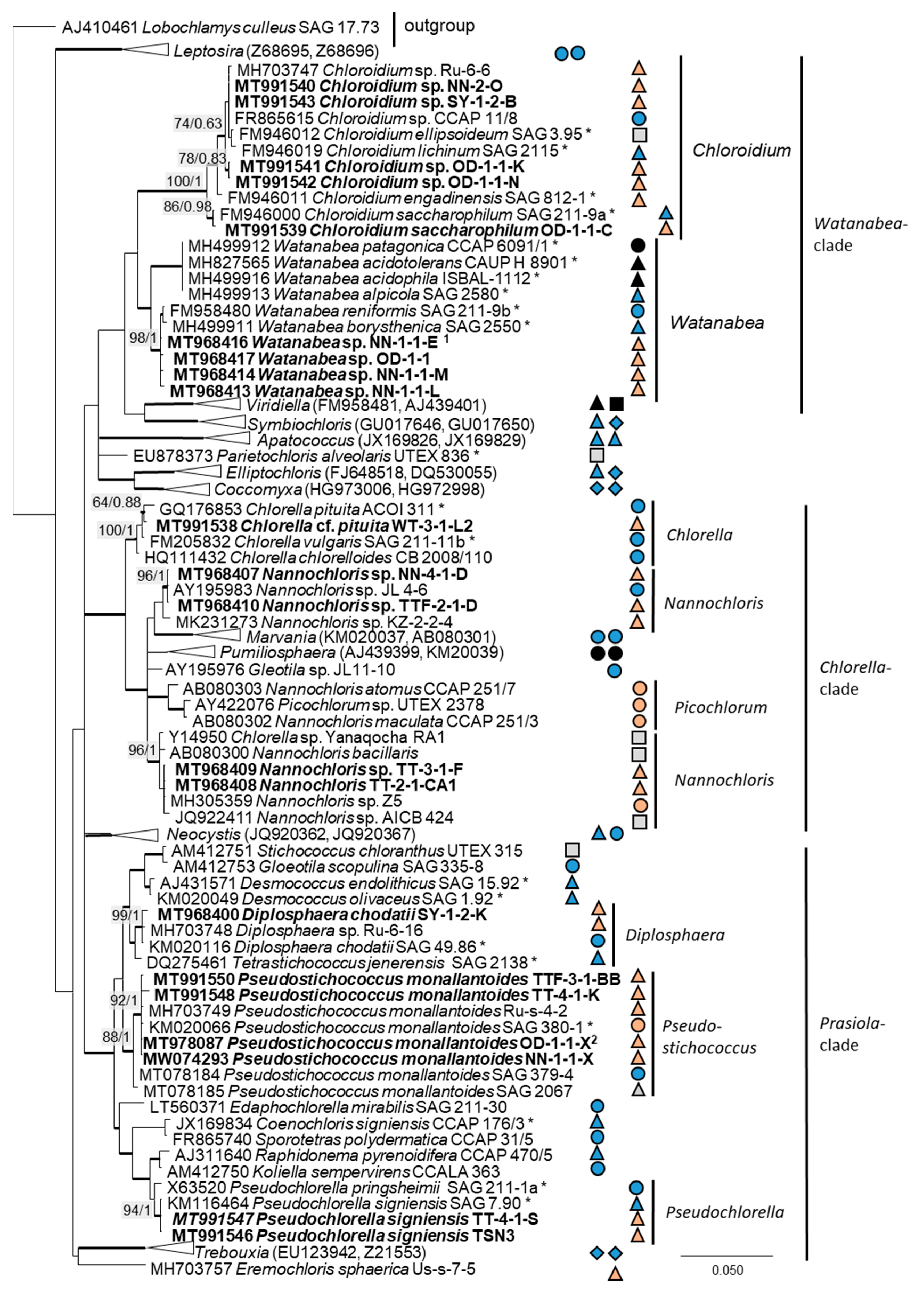
 ); nonsaline (
); nonsaline (  ); other extremes (
); other extremes (  e.g., radioactivity); and unknown (
e.g., radioactivity); and unknown (  ) habitats.
) habitats.
 ); nonsaline (
); nonsaline (  ); other extremes (
); other extremes (  e.g., radioactivity); and unknown (
e.g., radioactivity); and unknown (  ) habitats.
) habitats.






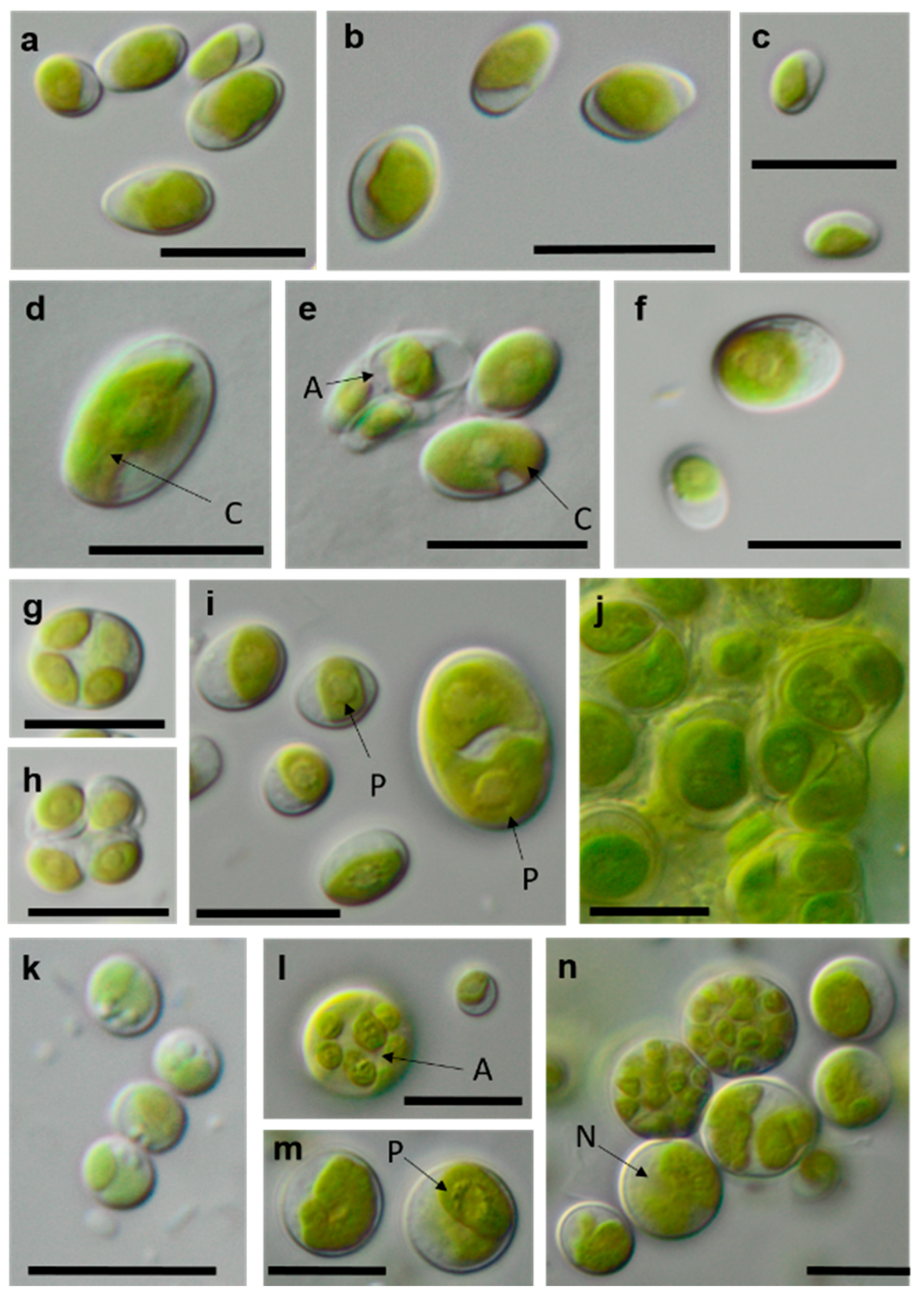

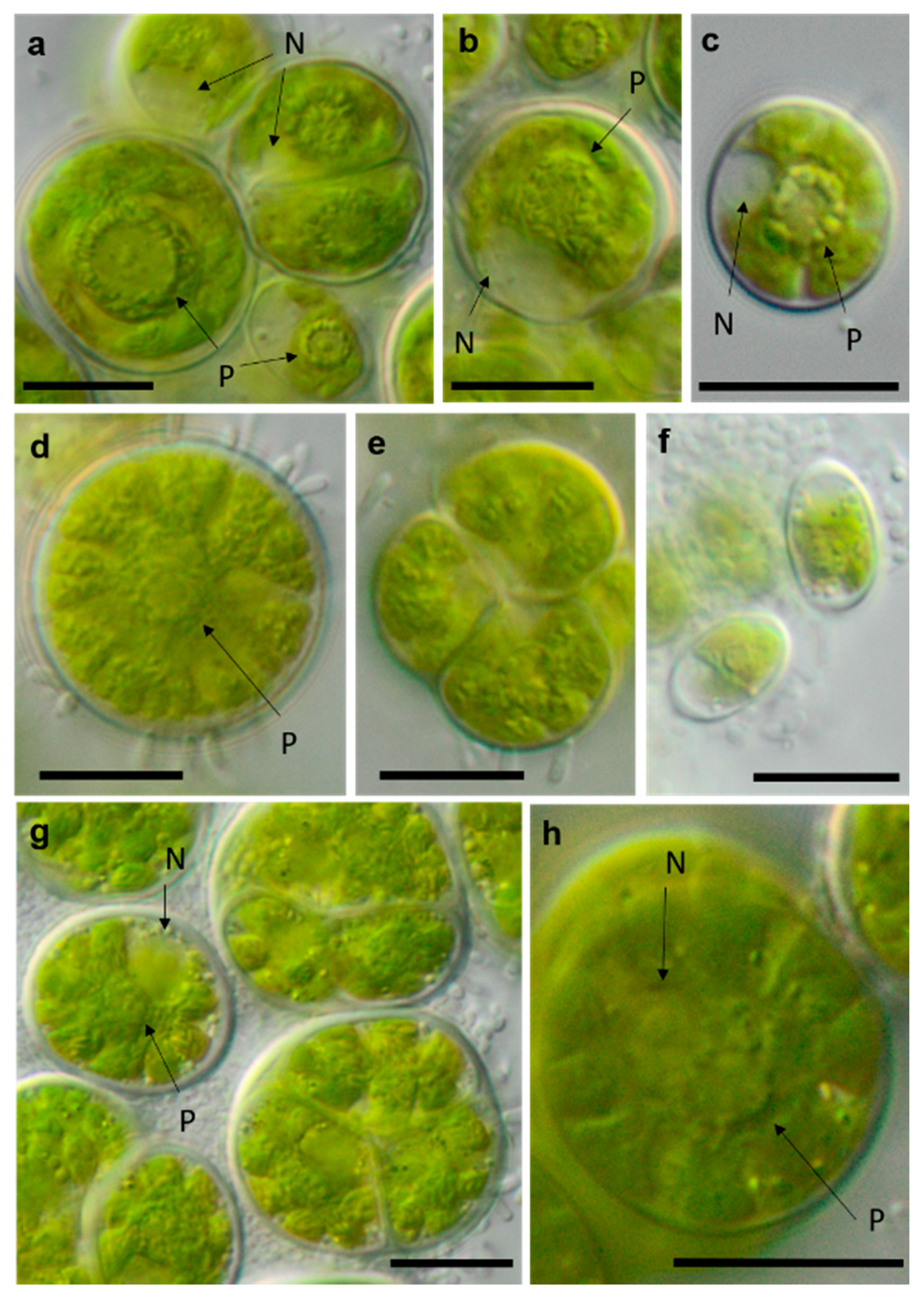
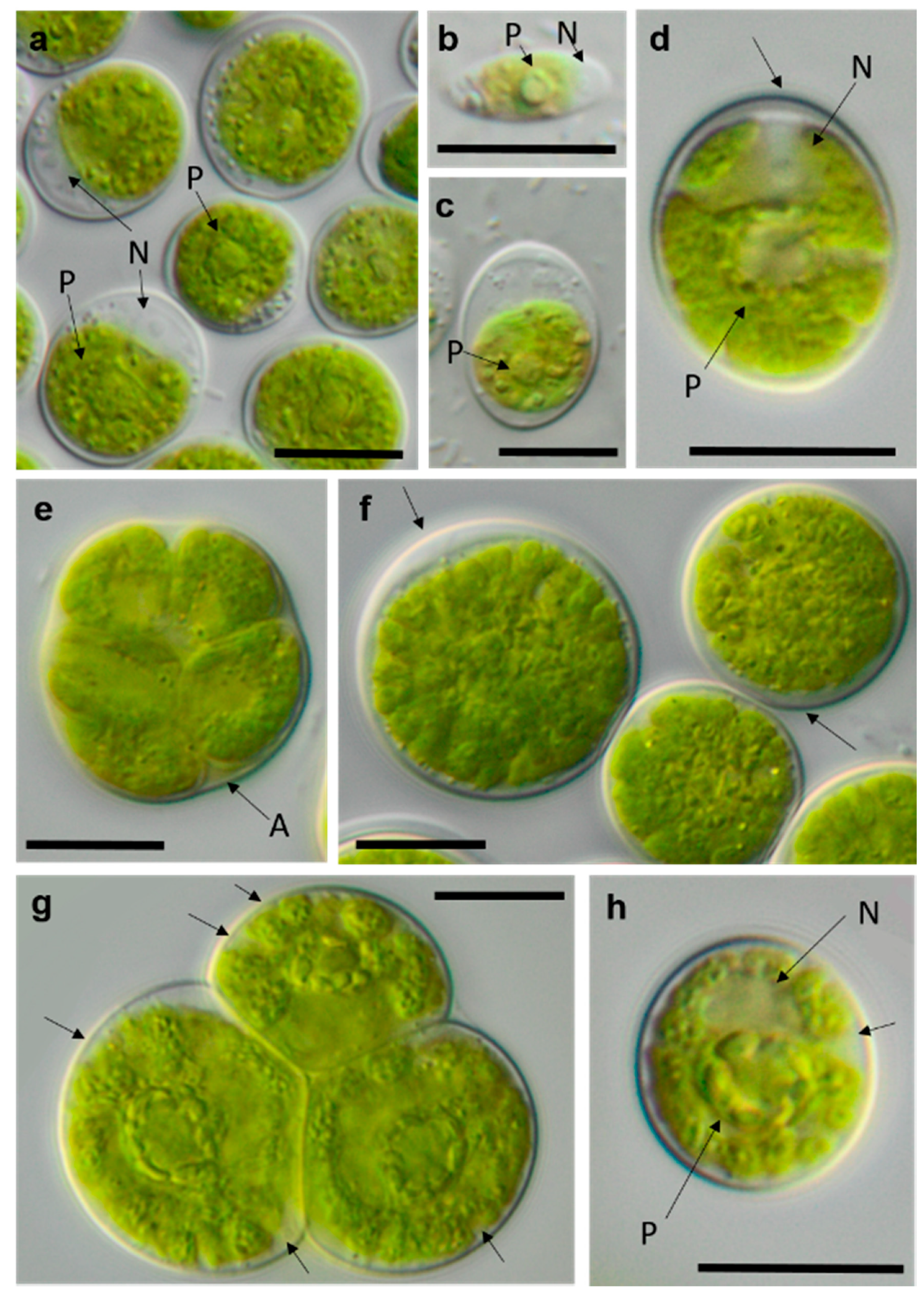
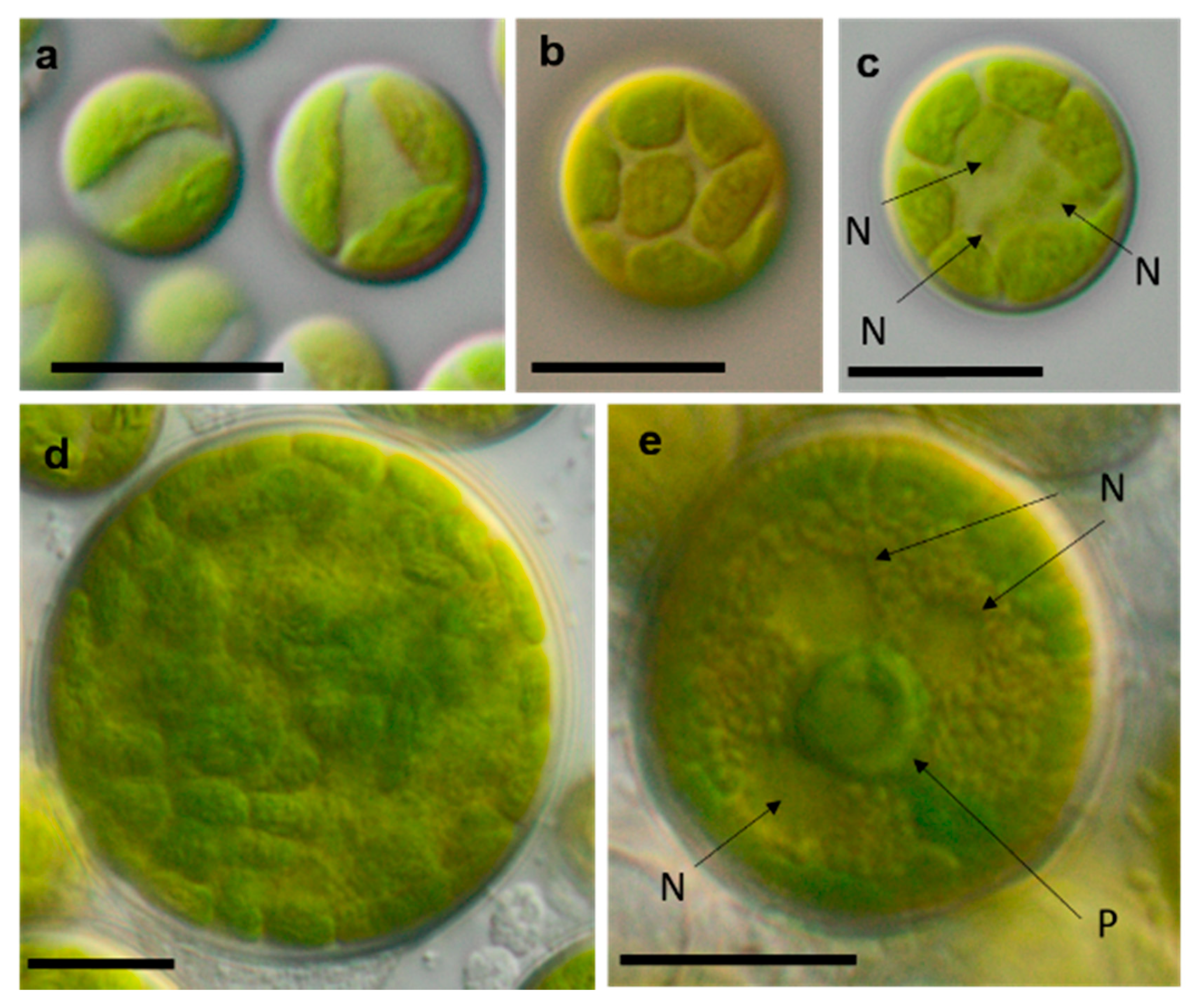
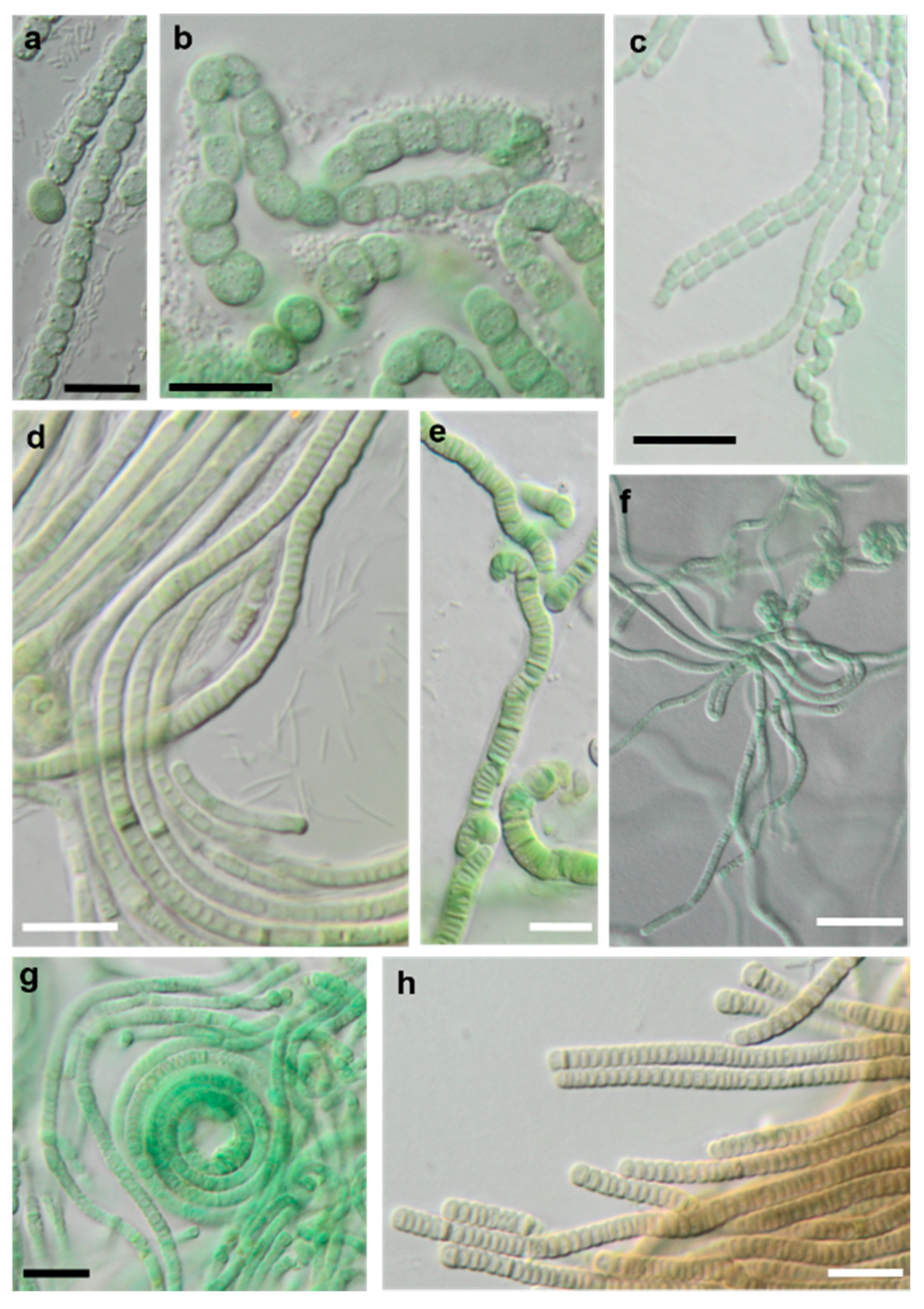
| Original Strain | Integrated Approach | Morphological Approach [63] | Comments | Reference |
|---|---|---|---|---|
| Chlamydomonadales | ||||
| NN-4-1-N N-4-1-E | Borodinellopsis texensis | Borodinellopsis texensis | SSU rRNA sequences of the original strains were close to the authentic strain (SAG 17.95). | [104,105] |
| NN-2-N NN-2-D | Borodinellopsis sp. • | Borodinellopsis sp. | SSU rRNA sequences of the original strains formed a separate sister branch to the authentic strain of B. texensis (SAG 17.95). | [104,105] |
| WT-3-1-F | Chloromonas sp. • | Radiosphaera negevensis | SSU rRNA sequence of the original strain formed a separate lineage within Chloromonas together with the strain Ru-6-8. | [65,106,107,108] |
| NN-1-1-Q | cf. Axilosphaera • | Tetracystis sp. | SSU rRNA sequence of the original strain formed a separate clade close to Axilosphaera and Eubrownia. | [105] |
| SY-1-2-T TT-3-1-Q (TSN3f) | cf. Chlorogonium • | Chlorococcum sp. 1 | SSU rRNA sequences of the original strains formed a separate lineage to Chlorogonium. | |
| SY-4-1-C TT-3-1-M | cf. Spongiococcum • | Tetracystis sp. | SSU rRNA sequences of the original strains formed a separate lineage within the Moewusinia. | [105] |
| (TTF-2-1-Da) | Alvikia sp. • | SSU rRNA sequences of the original strains formed a separate lineage within the Alvikia-clade. | [105] | |
| Sphaeropleales | ||||
| TT-3-1-J TT-3-1-U NN-4-1-D2 NN-4-1-CC NN-4-1-H (TTF-1-1-M) (TTF-2-1-A) (TTF-2-1-J) | Bracteacoccus minor | Bracteacoccus minor Bracteacoccus cohaerens Pseudomuriella aurantiaca | SSU rRNA and ITS2 sequences of the original strains were close to the authentic strain (UTEX 66). | [109] |
| TT-3-1-G | Tetradesmus dissociatus | Spongiochloris excentrica | SSU rRNA and ITS sequences of the original strain were close to the authentic strain of Tetradesmus dissociatus. | [110,111] |
| Ulvophyceae | ||||
| TT-4-1-I | Desmochloris cf. halophila • | Spongiochloris excentrica | SSU rRNA and ITS sequences of the original strain were in an intermediate position between the authentic strain of D. halophila (CCAP 6006/1) and D. mollenhaueri (CCAP 6006/2), forming a separate branch. | [69,112,113] |
| TT-4-1-D TT-4-1-M TT-4-1-O NN-4-1-Q NN-4-1-S NN-4-1-T | Halochlorococcum sp. • | Spongiochloris excentrica Spongiochloris sp. Chlorella sp. 1 Chlorococcum macropyrenoidosum | SSU rRNA sequences of the original strains clustered in the clade formed by Halochlorococcum species, but the absence of a taxonomic revision of the genus did not allow identification of the strains to species level. | [114,115] |
| TT-3-1-I TT-4-1-J TT-4-1-CC TT-4-1-F (G2C) | Planophila sp. • | Chlorella sp. 2 Chlorella sp. 3 Chlorella vulgaris Planophila sp. 1 | SSU rRNA and ITS sequences of the original strains formed a separate lineage within Planophila, distant from known species. | [69] |
| NN-4-1-B NN-4-1-M | cf. Chlorothrix • | Ulothrix aequalis | SSU rRNA and ITS sequences of the original strains formed a new lineage in the Acrosiphonia-clade of the Ulotrichales. | [113,116,117] |
| Trebouxiophyceae | ||||
| WT-3-1-L2 | Chlorella cf. pituita | Chlorella sp. 2 | SSU rRNA and ITS sequences of the original strain formed a separate branch from the authentic strain of C. pituita (ACOI 311). | [97] |
| OD-1-1-C | Chloroidium saccharophilum | Chloroidium ellipsoideum | SSU rRNA and ITS sequences of the original strain were close to the authentic strain (SAG 211-9a). | [68,118] |
| OD-1-2-N OD-1-1-K SY-1-2-B NN-2-O | Chloroidium sp. • | Chloroidium ellipsoideum | SSU rRNA and ITS sequences of the original strains fell on separate branches from C. lichinum and C. ellipsoideum. | [68,118] |
| SY-1-2-K | Diplosphaera chodatii | Diplosphaera chodatii | SSU rRNA and ITS sequences of the original strain were close to the authentic strain (SAG 48.86). | [119] |
| TT-2-1-CA1 TT-3-1-F NN-4-1-D (TTF-2-1-D) | Nannochloris sp. | Nannochloris sp. | SSU rRNA sequences of the original strains fell in two separate lineages within Nannochloris-like algae. No revision has addressed the polyphyletic positions of Nannchloris. | [101,120] |
| TT-4-1-S (TSN1) (TSN3) | Pseudochlorella signiensis | Parietochloris cf. cohaerens | SSU rRNA and ITS sequences of the original strains were close to the authentic strain of P. signiensis (SAG 7.90). | [121] |
| TT-4-1-K OD-1-1-X WT-3-1-P1 WT-3-1-A SY-1-2-P WT-3-1-H NN-1-1-X (TTF-3-1-BB) | Pseudosticho- coccus monallantoides | Stichococcus bacillaris Stichococcus exiguus Stichococcus allas | SSU rRNA and ITS sequences of the original strains were close to the authentic strain of P. monallantoides (SAG 380-1). | [119] |
| NN-2-1-X1B OD-1-1 NN-1-1-E NN-1-1-M NN-1-1-L | Watanabea sp. | Parietochloris cohaerens Parietochloris cf. ovoideus | SSU rRNA and ITS sequences of the original strains formed a separate lineage within Watanabea. | [70] |
| Cyanobacteria | ||||
| SY-1-2-EE SY-1-2-Y | Cyanocohniella sp. | Nostoc sp. | SSU rRNA and ITS sequences of the original strains formed separate lineages close to Cyanocohniella. | [75,76] |
| OD-1-1-T SY-4-1-H | Nodosilinea bijugata | Leptolyngbya sp. | SSU rRNA and ITS sequences of the original strains were close to the authentic strain of N. bijugata (Kovacik 1986/5a). | [122] |
| NN-2-1-EE NN-3-1-CD TT-1-1-CA | Nodosilinea cf. signiensis | Leptolyngbya sp. | SSU rRNA and ITS sequences of the original strains were close to the authentic strain of N. signiensis (USMFM), but the clade thus formed was not statistically supported. | [123] |
| OD-2-1-CH | Nodosilinea sp. • | Leptolyngbya sp. | SSU rRNA and ITS sequences of the original strain formed a separate lineage with the unidentified strain KIOST-1. | [122] |
| NN-4-1-FF NN-3-1-CA NN-3-1-G NN-4-1-O | “Phormidesmis” sp. • | Pseudophormidium edaphicum Cyanobacteria 2 Cyanobacteria 5 | Unclear genus: no revision for the clade “Phormidesmis” present | [72] |
| NN-3-1-B NN-3-1-D | “Pseudophormidium” battersii • | Cyanobacteria 5 Cyanobacteria 2 | Unclear genus: SSU rRNA sequences of the original strains formed a separate clade together with the strain KZ-16-2 previously identified as “Pseudophormidium” battersii. The group requires revision. | [72] |
Publisher’s Note: MDPI stays neutral with regard to jurisdictional claims in published maps and institutional affiliations. |
© 2020 by the authors. Licensee MDPI, Basel, Switzerland. This article is an open access article distributed under the terms and conditions of the Creative Commons Attribution (CC BY) license (http://creativecommons.org/licenses/by/4.0/).
Share and Cite
Sommer, V.; Mikhailyuk, T.; Glaser, K.; Karsten, U. Uncovering Unique Green Algae and Cyanobacteria Isolated from Biocrusts in Highly Saline Potash Tailing Pile Habitats, Using an Integrative Approach. Microorganisms 2020, 8, 1667. https://doi.org/10.3390/microorganisms8111667
Sommer V, Mikhailyuk T, Glaser K, Karsten U. Uncovering Unique Green Algae and Cyanobacteria Isolated from Biocrusts in Highly Saline Potash Tailing Pile Habitats, Using an Integrative Approach. Microorganisms. 2020; 8(11):1667. https://doi.org/10.3390/microorganisms8111667
Chicago/Turabian StyleSommer, Veronika, Tatiana Mikhailyuk, Karin Glaser, and Ulf Karsten. 2020. "Uncovering Unique Green Algae and Cyanobacteria Isolated from Biocrusts in Highly Saline Potash Tailing Pile Habitats, Using an Integrative Approach" Microorganisms 8, no. 11: 1667. https://doi.org/10.3390/microorganisms8111667
APA StyleSommer, V., Mikhailyuk, T., Glaser, K., & Karsten, U. (2020). Uncovering Unique Green Algae and Cyanobacteria Isolated from Biocrusts in Highly Saline Potash Tailing Pile Habitats, Using an Integrative Approach. Microorganisms, 8(11), 1667. https://doi.org/10.3390/microorganisms8111667





